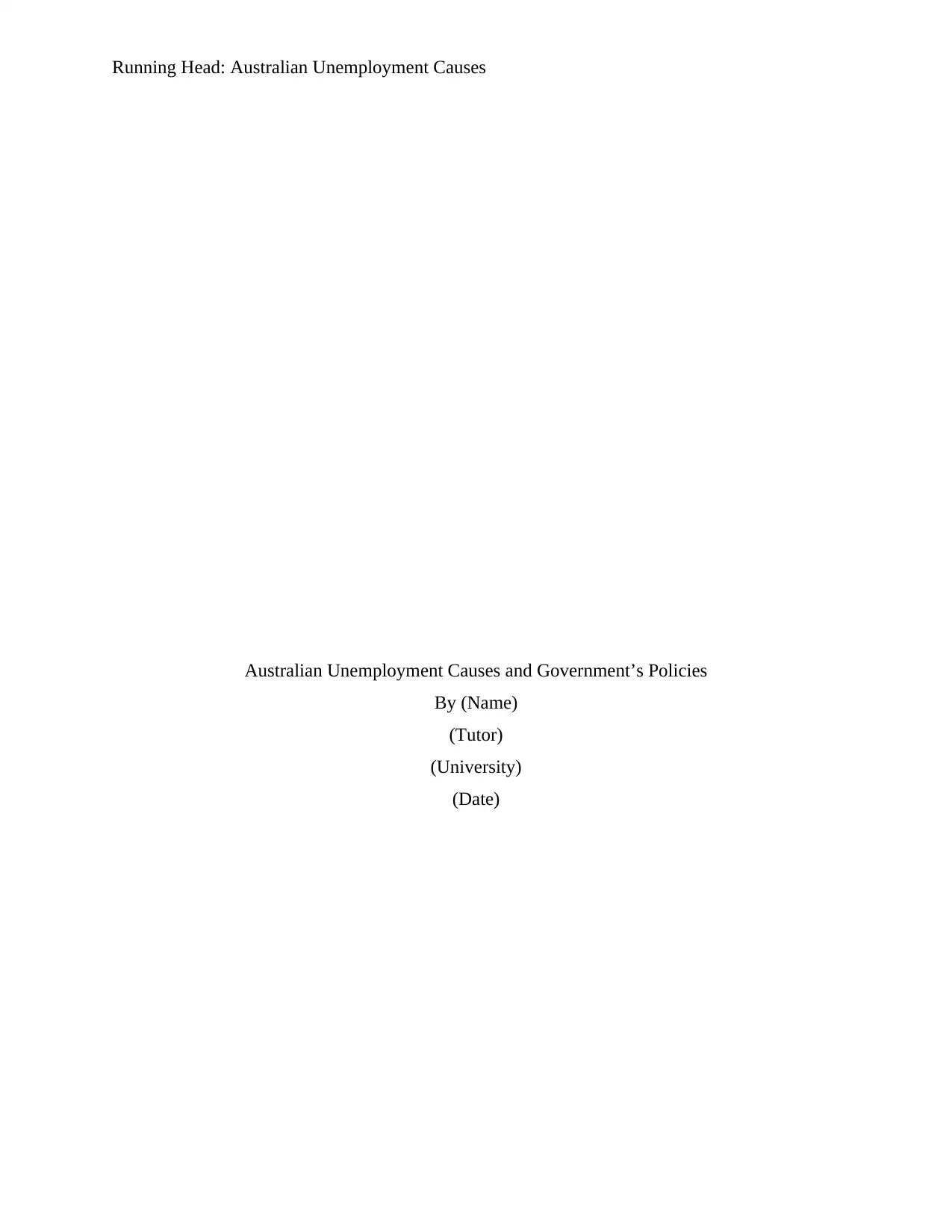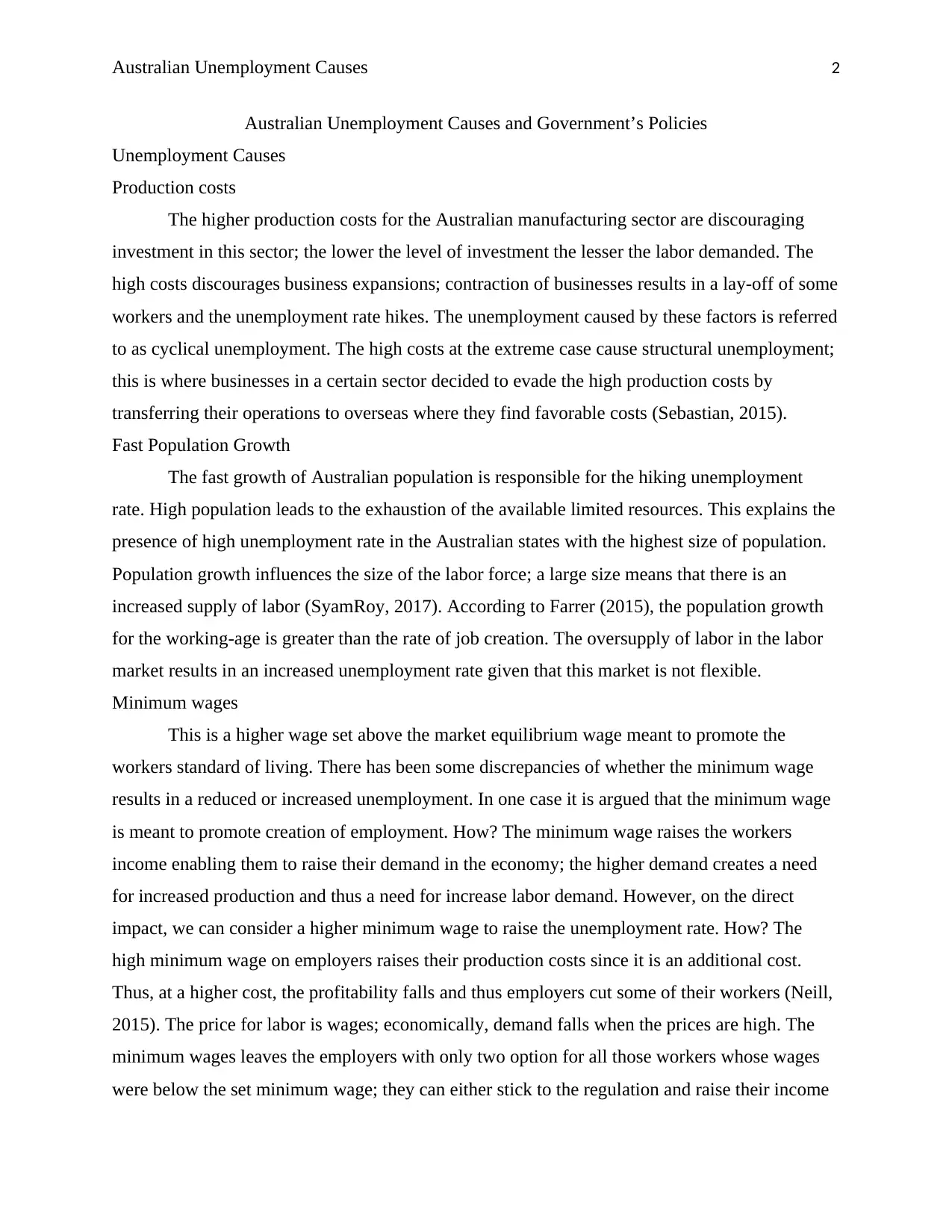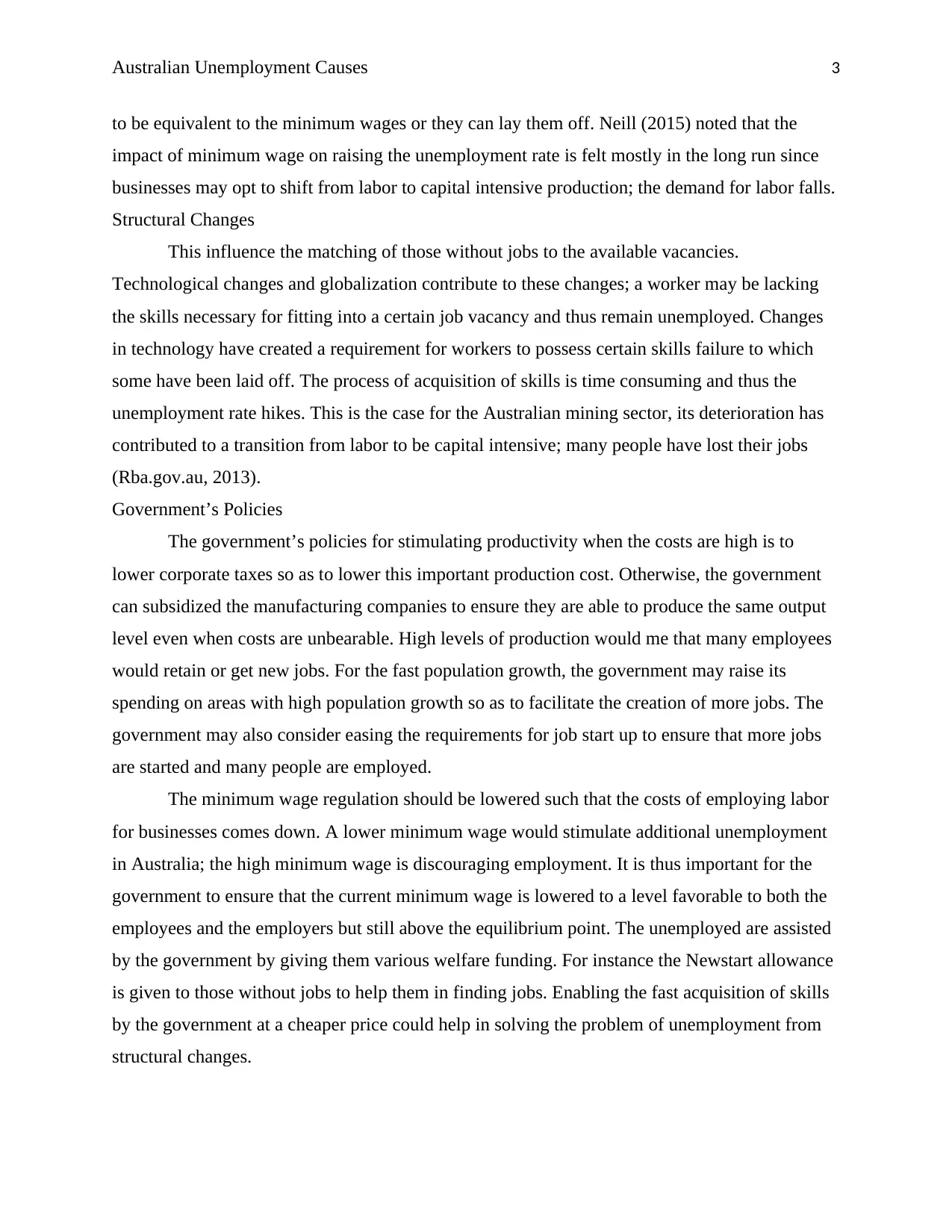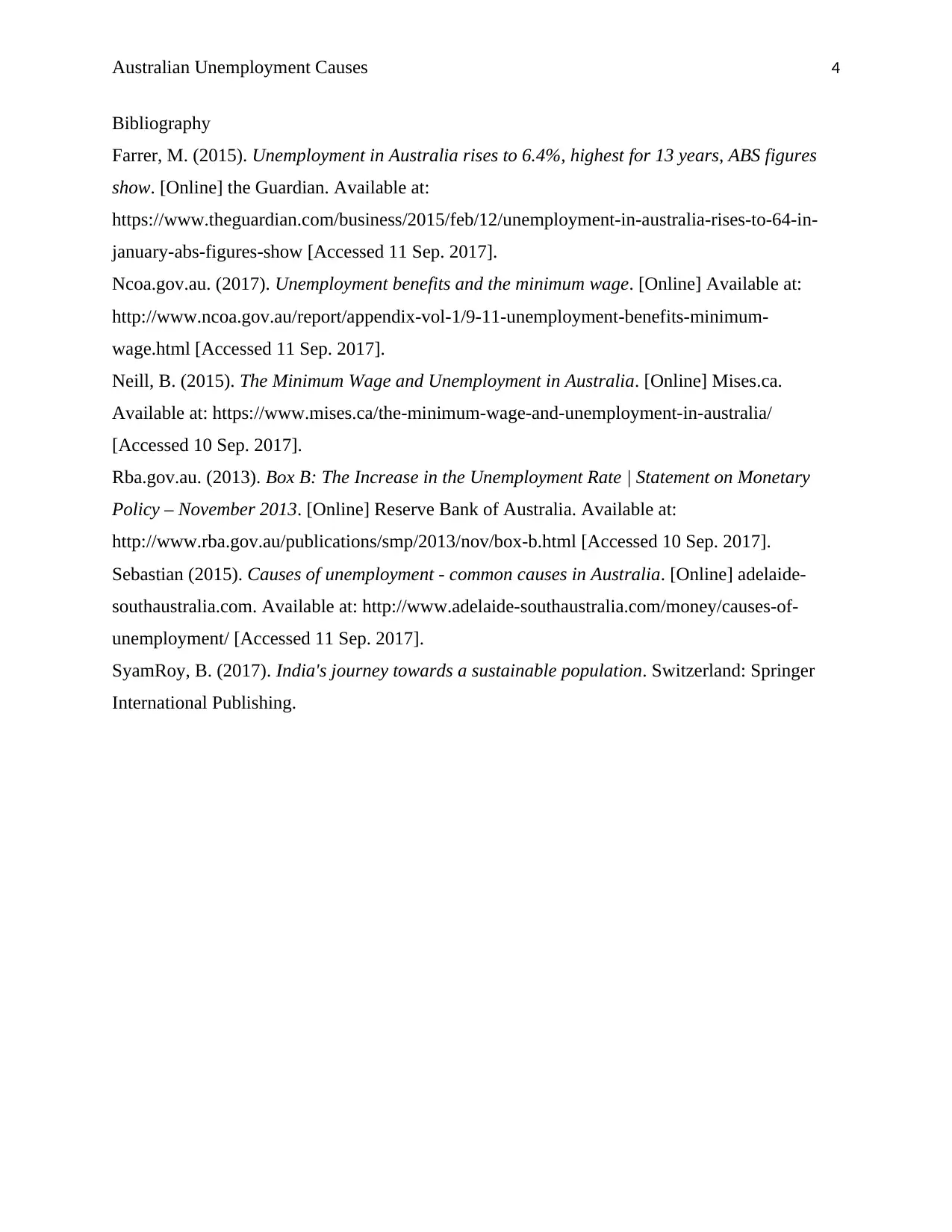Causes of Unemployment in Australia and Government Policies Review
VerifiedAdded on 2019/10/31
|4
|1114
|172
Report
AI Summary
This report delves into the multifaceted causes of unemployment in Australia, examining factors such as rising production costs, rapid population growth, minimum wage regulations, and structural changes within the economy. It explores how higher production costs discourage investment and lead to cyclical unemployment, while rapid population growth strains resources and increases the labor supply. The report also discusses the controversial impact of minimum wages, analyzing both potential benefits and drawbacks. Furthermore, it highlights structural changes, like technological advancements and globalization, which necessitate specific skill sets. The report then evaluates the Australian government's policies aimed at addressing these challenges, including corporate tax adjustments, subsidies, welfare programs, and skill development initiatives. The analysis considers the effectiveness of these policies in stimulating productivity, creating jobs, and mitigating the effects of unemployment.

Running Head: Australian Unemployment Causes
Australian Unemployment Causes and Government’s Policies
By (Name)
(Tutor)
(University)
(Date)
Australian Unemployment Causes and Government’s Policies
By (Name)
(Tutor)
(University)
(Date)
Paraphrase This Document
Need a fresh take? Get an instant paraphrase of this document with our AI Paraphraser

Australian Unemployment Causes 2
Australian Unemployment Causes and Government’s Policies
Unemployment Causes
Production costs
The higher production costs for the Australian manufacturing sector are discouraging
investment in this sector; the lower the level of investment the lesser the labor demanded. The
high costs discourages business expansions; contraction of businesses results in a lay-off of some
workers and the unemployment rate hikes. The unemployment caused by these factors is referred
to as cyclical unemployment. The high costs at the extreme case cause structural unemployment;
this is where businesses in a certain sector decided to evade the high production costs by
transferring their operations to overseas where they find favorable costs (Sebastian, 2015).
Fast Population Growth
The fast growth of Australian population is responsible for the hiking unemployment
rate. High population leads to the exhaustion of the available limited resources. This explains the
presence of high unemployment rate in the Australian states with the highest size of population.
Population growth influences the size of the labor force; a large size means that there is an
increased supply of labor (SyamRoy, 2017). According to Farrer (2015), the population growth
for the working-age is greater than the rate of job creation. The oversupply of labor in the labor
market results in an increased unemployment rate given that this market is not flexible.
Minimum wages
This is a higher wage set above the market equilibrium wage meant to promote the
workers standard of living. There has been some discrepancies of whether the minimum wage
results in a reduced or increased unemployment. In one case it is argued that the minimum wage
is meant to promote creation of employment. How? The minimum wage raises the workers
income enabling them to raise their demand in the economy; the higher demand creates a need
for increased production and thus a need for increase labor demand. However, on the direct
impact, we can consider a higher minimum wage to raise the unemployment rate. How? The
high minimum wage on employers raises their production costs since it is an additional cost.
Thus, at a higher cost, the profitability falls and thus employers cut some of their workers (Neill,
2015). The price for labor is wages; economically, demand falls when the prices are high. The
minimum wages leaves the employers with only two option for all those workers whose wages
were below the set minimum wage; they can either stick to the regulation and raise their income
Australian Unemployment Causes and Government’s Policies
Unemployment Causes
Production costs
The higher production costs for the Australian manufacturing sector are discouraging
investment in this sector; the lower the level of investment the lesser the labor demanded. The
high costs discourages business expansions; contraction of businesses results in a lay-off of some
workers and the unemployment rate hikes. The unemployment caused by these factors is referred
to as cyclical unemployment. The high costs at the extreme case cause structural unemployment;
this is where businesses in a certain sector decided to evade the high production costs by
transferring their operations to overseas where they find favorable costs (Sebastian, 2015).
Fast Population Growth
The fast growth of Australian population is responsible for the hiking unemployment
rate. High population leads to the exhaustion of the available limited resources. This explains the
presence of high unemployment rate in the Australian states with the highest size of population.
Population growth influences the size of the labor force; a large size means that there is an
increased supply of labor (SyamRoy, 2017). According to Farrer (2015), the population growth
for the working-age is greater than the rate of job creation. The oversupply of labor in the labor
market results in an increased unemployment rate given that this market is not flexible.
Minimum wages
This is a higher wage set above the market equilibrium wage meant to promote the
workers standard of living. There has been some discrepancies of whether the minimum wage
results in a reduced or increased unemployment. In one case it is argued that the minimum wage
is meant to promote creation of employment. How? The minimum wage raises the workers
income enabling them to raise their demand in the economy; the higher demand creates a need
for increased production and thus a need for increase labor demand. However, on the direct
impact, we can consider a higher minimum wage to raise the unemployment rate. How? The
high minimum wage on employers raises their production costs since it is an additional cost.
Thus, at a higher cost, the profitability falls and thus employers cut some of their workers (Neill,
2015). The price for labor is wages; economically, demand falls when the prices are high. The
minimum wages leaves the employers with only two option for all those workers whose wages
were below the set minimum wage; they can either stick to the regulation and raise their income

Australian Unemployment Causes 3
to be equivalent to the minimum wages or they can lay them off. Neill (2015) noted that the
impact of minimum wage on raising the unemployment rate is felt mostly in the long run since
businesses may opt to shift from labor to capital intensive production; the demand for labor falls.
Structural Changes
This influence the matching of those without jobs to the available vacancies.
Technological changes and globalization contribute to these changes; a worker may be lacking
the skills necessary for fitting into a certain job vacancy and thus remain unemployed. Changes
in technology have created a requirement for workers to possess certain skills failure to which
some have been laid off. The process of acquisition of skills is time consuming and thus the
unemployment rate hikes. This is the case for the Australian mining sector, its deterioration has
contributed to a transition from labor to be capital intensive; many people have lost their jobs
(Rba.gov.au, 2013).
Government’s Policies
The government’s policies for stimulating productivity when the costs are high is to
lower corporate taxes so as to lower this important production cost. Otherwise, the government
can subsidized the manufacturing companies to ensure they are able to produce the same output
level even when costs are unbearable. High levels of production would me that many employees
would retain or get new jobs. For the fast population growth, the government may raise its
spending on areas with high population growth so as to facilitate the creation of more jobs. The
government may also consider easing the requirements for job start up to ensure that more jobs
are started and many people are employed.
The minimum wage regulation should be lowered such that the costs of employing labor
for businesses comes down. A lower minimum wage would stimulate additional unemployment
in Australia; the high minimum wage is discouraging employment. It is thus important for the
government to ensure that the current minimum wage is lowered to a level favorable to both the
employees and the employers but still above the equilibrium point. The unemployed are assisted
by the government by giving them various welfare funding. For instance the Newstart allowance
is given to those without jobs to help them in finding jobs. Enabling the fast acquisition of skills
by the government at a cheaper price could help in solving the problem of unemployment from
structural changes.
to be equivalent to the minimum wages or they can lay them off. Neill (2015) noted that the
impact of minimum wage on raising the unemployment rate is felt mostly in the long run since
businesses may opt to shift from labor to capital intensive production; the demand for labor falls.
Structural Changes
This influence the matching of those without jobs to the available vacancies.
Technological changes and globalization contribute to these changes; a worker may be lacking
the skills necessary for fitting into a certain job vacancy and thus remain unemployed. Changes
in technology have created a requirement for workers to possess certain skills failure to which
some have been laid off. The process of acquisition of skills is time consuming and thus the
unemployment rate hikes. This is the case for the Australian mining sector, its deterioration has
contributed to a transition from labor to be capital intensive; many people have lost their jobs
(Rba.gov.au, 2013).
Government’s Policies
The government’s policies for stimulating productivity when the costs are high is to
lower corporate taxes so as to lower this important production cost. Otherwise, the government
can subsidized the manufacturing companies to ensure they are able to produce the same output
level even when costs are unbearable. High levels of production would me that many employees
would retain or get new jobs. For the fast population growth, the government may raise its
spending on areas with high population growth so as to facilitate the creation of more jobs. The
government may also consider easing the requirements for job start up to ensure that more jobs
are started and many people are employed.
The minimum wage regulation should be lowered such that the costs of employing labor
for businesses comes down. A lower minimum wage would stimulate additional unemployment
in Australia; the high minimum wage is discouraging employment. It is thus important for the
government to ensure that the current minimum wage is lowered to a level favorable to both the
employees and the employers but still above the equilibrium point. The unemployed are assisted
by the government by giving them various welfare funding. For instance the Newstart allowance
is given to those without jobs to help them in finding jobs. Enabling the fast acquisition of skills
by the government at a cheaper price could help in solving the problem of unemployment from
structural changes.
⊘ This is a preview!⊘
Do you want full access?
Subscribe today to unlock all pages.

Trusted by 1+ million students worldwide

Australian Unemployment Causes 4
Bibliography
Farrer, M. (2015). Unemployment in Australia rises to 6.4%, highest for 13 years, ABS figures
show. [Online] the Guardian. Available at:
https://www.theguardian.com/business/2015/feb/12/unemployment-in-australia-rises-to-64-in-
january-abs-figures-show [Accessed 11 Sep. 2017].
Ncoa.gov.au. (2017). Unemployment benefits and the minimum wage. [Online] Available at:
http://www.ncoa.gov.au/report/appendix-vol-1/9-11-unemployment-benefits-minimum-
wage.html [Accessed 11 Sep. 2017].
Neill, B. (2015). The Minimum Wage and Unemployment in Australia. [Online] Mises.ca.
Available at: https://www.mises.ca/the-minimum-wage-and-unemployment-in-australia/
[Accessed 10 Sep. 2017].
Rba.gov.au. (2013). Box B: The Increase in the Unemployment Rate | Statement on Monetary
Policy – November 2013. [Online] Reserve Bank of Australia. Available at:
http://www.rba.gov.au/publications/smp/2013/nov/box-b.html [Accessed 10 Sep. 2017].
Sebastian (2015). Causes of unemployment - common causes in Australia. [Online] adelaide-
southaustralia.com. Available at: http://www.adelaide-southaustralia.com/money/causes-of-
unemployment/ [Accessed 11 Sep. 2017].
SyamRoy, B. (2017). India's journey towards a sustainable population. Switzerland: Springer
International Publishing.
Bibliography
Farrer, M. (2015). Unemployment in Australia rises to 6.4%, highest for 13 years, ABS figures
show. [Online] the Guardian. Available at:
https://www.theguardian.com/business/2015/feb/12/unemployment-in-australia-rises-to-64-in-
january-abs-figures-show [Accessed 11 Sep. 2017].
Ncoa.gov.au. (2017). Unemployment benefits and the minimum wage. [Online] Available at:
http://www.ncoa.gov.au/report/appendix-vol-1/9-11-unemployment-benefits-minimum-
wage.html [Accessed 11 Sep. 2017].
Neill, B. (2015). The Minimum Wage and Unemployment in Australia. [Online] Mises.ca.
Available at: https://www.mises.ca/the-minimum-wage-and-unemployment-in-australia/
[Accessed 10 Sep. 2017].
Rba.gov.au. (2013). Box B: The Increase in the Unemployment Rate | Statement on Monetary
Policy – November 2013. [Online] Reserve Bank of Australia. Available at:
http://www.rba.gov.au/publications/smp/2013/nov/box-b.html [Accessed 10 Sep. 2017].
Sebastian (2015). Causes of unemployment - common causes in Australia. [Online] adelaide-
southaustralia.com. Available at: http://www.adelaide-southaustralia.com/money/causes-of-
unemployment/ [Accessed 11 Sep. 2017].
SyamRoy, B. (2017). India's journey towards a sustainable population. Switzerland: Springer
International Publishing.
1 out of 4
Related Documents
Your All-in-One AI-Powered Toolkit for Academic Success.
+13062052269
info@desklib.com
Available 24*7 on WhatsApp / Email
![[object Object]](/_next/static/media/star-bottom.7253800d.svg)
Unlock your academic potential
Copyright © 2020–2025 A2Z Services. All Rights Reserved. Developed and managed by ZUCOL.





